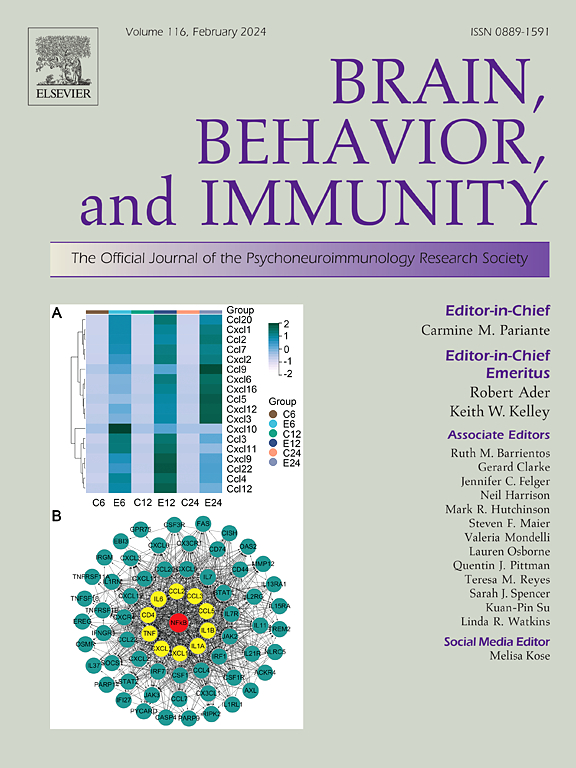GDF15-GFRAL信号驱动肌萎缩性侧索硬化小鼠模型的体重减轻和脂质代谢。
IF 8.8
2区 医学
Q1 IMMUNOLOGY
引用次数: 0
摘要
体重减轻是肌萎缩性侧索硬化症(ALS)患者常见的早期症状,与生存呈负相关。在不同的癌症和代谢紊乱中,高水平的血清生长分化因子15 (GDF15)通过GDNF家族受体α样(GFRAL)起作用,有助于减少食物摄入量和体重。本文报道了GDF15在ALS患者外周血和hSOD1G93A小鼠模型中高表达,GFRAL在hSOD1G93A小鼠脑干中上调。结果表明,shRNA在hSOD1G93A小鼠静息后/孤束核区域局部沉默GFRAL可诱导体重增加,减少脂肪组织消耗,改善运动功能和肌肉萎缩,延长生存时间。我们报道,小胶质细胞可能参与介导这些效应,因为PLX5622减少它们会减少脑干GDF15的表达、体重减轻和脂肪组织中脂溶基因的表达。综上所述,这些结果揭示了GDF15-GFRAL信号在ALS早期调节体重减轻和脂质代谢改变中的关键作用。本文章由计算机程序翻译,如有差异,请以英文原文为准。

GDF15-GFRAL signaling drives weight loss and lipid metabolism in mouse model of amyotrophic lateral sclerosis
Weight loss is a common early sign in amyotrophic lateral sclerosis (ALS) patients and negatively correlates with survival. In different cancers and metabolic disorders, high levels of serum growth differentiation factor 15 (GDF15) contribute to a decrease of food intake and body weight, acting through GDNF family receptor alpha-like (GFRAL). Here we report that GDF15 is highly expressed in the peripheral blood of ALS patients and in the hSOD1G93A mouse model and that GFRAL is upregulated in the brainstem of hSOD1G93A mice. We demonstrate that the localized GFRAL silencing by shRNA in the area postrema/nucleus tractus solitarius of hSOD1G93A mice induces weight gain, reduces adipose tissue wasting, ameliorates the motor function and muscle atrophy and prolongs the survival time. We report that microglial cells could be involved in mediating these effects because their depletion with PLX5622 reduces brainstem GDF15 expression, weight loss and the expression of lipolytic genes in adipose tissue. Altogether these results reveal a key role of GDF15-GFRAL signaling in regulating weight loss and the alteration of and lipid metabolism in the early phases of ALS.
求助全文
通过发布文献求助,成功后即可免费获取论文全文。
去求助
来源期刊
CiteScore
29.60
自引率
2.00%
发文量
290
审稿时长
28 days
期刊介绍:
Established in 1987, Brain, Behavior, and Immunity proudly serves as the official journal of the Psychoneuroimmunology Research Society (PNIRS). This pioneering journal is dedicated to publishing peer-reviewed basic, experimental, and clinical studies that explore the intricate interactions among behavioral, neural, endocrine, and immune systems in both humans and animals.
As an international and interdisciplinary platform, Brain, Behavior, and Immunity focuses on original research spanning neuroscience, immunology, integrative physiology, behavioral biology, psychiatry, psychology, and clinical medicine. The journal is inclusive of research conducted at various levels, including molecular, cellular, social, and whole organism perspectives. With a commitment to efficiency, the journal facilitates online submission and review, ensuring timely publication of experimental results. Manuscripts typically undergo peer review and are returned to authors within 30 days of submission. It's worth noting that Brain, Behavior, and Immunity, published eight times a year, does not impose submission fees or page charges, fostering an open and accessible platform for scientific discourse.

 求助内容:
求助内容: 应助结果提醒方式:
应助结果提醒方式:


